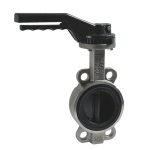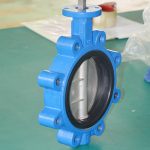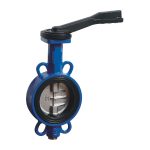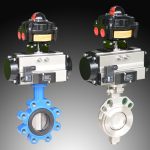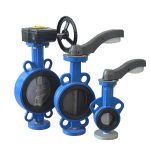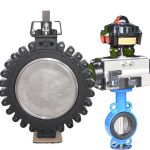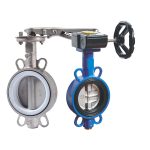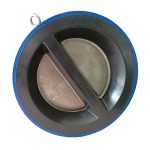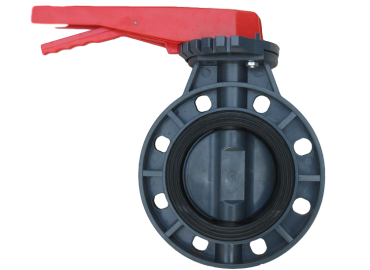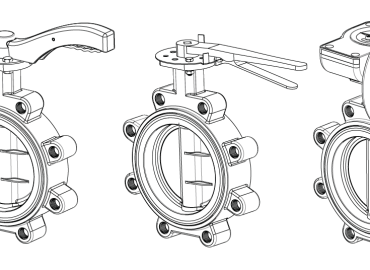Butterfly wafer type valves are widely utilized in various industries due to their compact design, cost-effectiveness, and efficient flow control capabilities. Ensuring proper sealing when using these valves is crucial for maintaining optimal system performance, preventing leaks, and safeguarding against potential hazards. Achieving a reliable seal requires careful consideration of factors such as material compatibility, correct installation and alignment, regular inspection and maintenance, and adherence to industry best practices. This blog post aims to provide a comprehensive guide on how to ensure proper sealing in butterfly wafer type valves, ultimately contributing to the efficiency, safety, and longevity of your flow control systems.
Introduction
Ensuring proper sealing when using wafer butterfly valve is a multi-faceted process that requires attention to detail and adherence to best practices. First and foremost, selecting the appropriate valve materials is crucial, as material compatibility plays a significant role in the valve’s ability to maintain a reliable seal. This involves choosing suitable materials for the valve body, disc, and seat based on factors such as temperature, pressure, and fluid type. Next, correct installation and alignment are essential in preventing leaks and ensuring efficient operation. This includes proper orientation and positioning of the valve within the piping system, ensuring clean and undamaged flange surfaces, selecting the appropriate gasket, and following specified bolting patterns and torque requirements. Regular inspection and maintenance are also vital in maintaining proper sealing, as periodic visual inspections can help identify signs of wear or damage, while functionality tests confirm proper operation. Scheduled maintenance tasks such as lubrication, cleaning, and component replacements can further enhance the valve’s performance and longevity. Finally, consulting with experienced professionals and adhering to industry standards and guidelines are key to achieving optimal sealing in butterfly wafer type valves. By engaging with experts and following best practices, users can ensure that their valves remain reliable, efficient, and safe throughout their service life, contributing to the overall success and stability of their flow control systems.
Brief overview of butterfly wafer type valves
Butterfly wafer type valves are a popular category of flow control devices known for their compact design, ease of operation, and cost-effectiveness. These valves consist of a flat, circular disc mounted on a central stem, which rotates to regulate fluid flow within a pipeline. When the disc is parallel to the flow, the valve is fully open, allowing fluid to pass through with minimal resistance. Conversely, when the disc is perpendicular to the flow, the valve is closed, effectively blocking the passage of fluid. The wafer-style body of these valves allows for easy installation between flanges in a piping system, making them an ideal choice for various industrial applications, including water treatment, chemical processing, and HVAC systems. Butterfly wafer type valves offer several advantages, such as a smaller footprint, lower weight, and reduced maintenance requirements compared to other valve types, making them a widely favored option for efficient and reliable flow control.
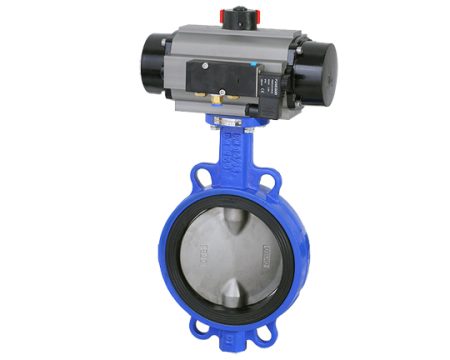
Importance of proper sealing for efficient operation and leak prevention
The importance of proper sealing in lug butterfly valve cannot be overstated, as it plays a critical role in ensuring efficient operation and leak prevention. A reliable seal between the valve’s disc and seat is vital for maintaining precise flow control, preventing fluid from bypassing the closed valve, and avoiding potential contamination or mixing of fluids in adjacent pipelines. In addition, effective sealing contributes to the overall safety and stability of the piping system, as leaks can lead to wasted resources, environmental hazards, and even dangerous operating conditions. Furthermore, proper sealing minimizes the risk of premature wear on valve components, reducing maintenance requirements and prolonging the service life of the valve. Therefore, achieving and maintaining a secure seal in butterfly wafer type valves is essential for optimizing system performance, enhancing safety, and maximizing the efficiency and longevity of these versatile flow control devices.
Selecting the appropriate valve materials
Selecting the appropriate valve materials is a critical aspect of ensuring proper sealing in butterfly wafer type valves. Material compatibility plays a significant role in the valve’s ability to maintain a reliable seal under varying conditions. The material choice for the valve body, disc, and seat depends on factors such as temperature, pressure, and fluid type. For example, a valve exposed to corrosive fluids or high temperatures may require materials such as stainless steel or high-temperature alloys. In contrast, valves used for potable water applications may require materials that meet drinking water standards, such as PVC or ductile iron. It is essential to consider all these factors when selecting the materials, as an incorrect choice can lead to premature wear, leaks, reduced performance, and even system failure. Therefore, careful consideration of material compatibility is crucial for achieving optimal sealing performance in butterfly wafer type valves.
Importance of material compatibility
The importance of material compatibility cannot be overemphasized when it comes to butterfly wafer type valves. The materials used for the valve’s body, disc, and seat must be compatible with the fluid being transported through the piping system. If incompatible materials are used, they may react with the fluid or with each other, leading to corrosion, erosion, or chemical reactions that can compromise the integrity of the valve. Such reactions can cause leaks, premature wear, and even system failure, resulting in costly downtime and repairs. Therefore, it is crucial to carefully consider material compatibility when selecting the appropriate materials for butterfly wafer type valves. By doing so, users can ensure that their valves maintain a reliable seal and operate efficiently, contributing to the safe, stable, and sustainable operation of their flow control systems.
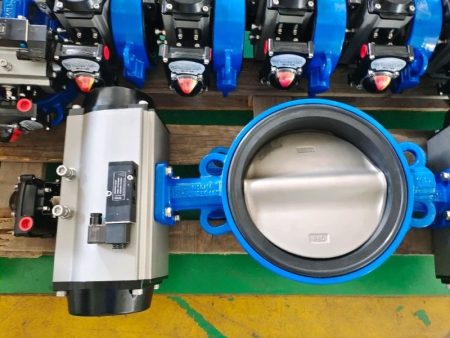
Common materials for valve components (body, disc, and seat)
Common materials for butterfly wafer type valve components include various metals, plastics, and elastomers. Metals such as cast iron, stainless steel, and aluminum are commonly used for the valve body due to their strength, durability, and resistance to high temperatures and pressures. The valve disc can also be made from metals such as stainless steel, carbon steel, or ductile iron, or from plastics such as polypropylene or PVC, depending on the application requirements. The valve seat is commonly made from elastomers such as EPDM, Buna-N, or Viton, which provide a secure seal against the valve disc while being resistant to chemical attack and abrasion. The choice of material for each component depends on the specific application’s temperature, pressure, and fluid type, and proper material selection is crucial for achieving optimal sealing performance in butterfly wafer type valves.
Factors to consider when choosing materials (temperature, pressure, and fluid type)
When choosing materials for butterfly wafer type valves, several factors must be considered to ensure optimal performance and sealing reliability. The first factor is temperature, as high temperatures can cause certain materials to deform or fail, while low temperatures can lead to embrittlement or cracking. The second factor is pressure, as higher pressures require stronger, more durable materials that can withstand the forces exerted on the valve components. Fluid type is also a crucial consideration, as different fluids can react negatively with some materials, leading to corrosion or erosion that can compromise the valve’s integrity. Other factors such as fluid velocity, flow rate, and system compatibility should also be considered when selecting valve materials. By taking all these factors into account, users can choose the most appropriate materials for each valve component, ensuring that the valve maintains a reliable seal and operates efficiently throughout its service life.
Correct installation and alignment
Correct installation and alignment are critical factors in ensuring the long-term reliability and proper functioning of butterfly wafer type valves. Proper installation begins with carefully following the manufacturer’s instructions regarding valve orientation, torque specifications, and gasket material selection. The valve’s orientation affects its ability to operate correctly, so it must be positioned appropriately for the specific application. Also, incorrect torque can cause leaks or damage to the valve components, so it is essential to use the recommended torque specifications indicated by the manufacturer. Gasket material selection must be compatible with the fluid being transported through the piping system and must be installed correctly to prevent leaks.
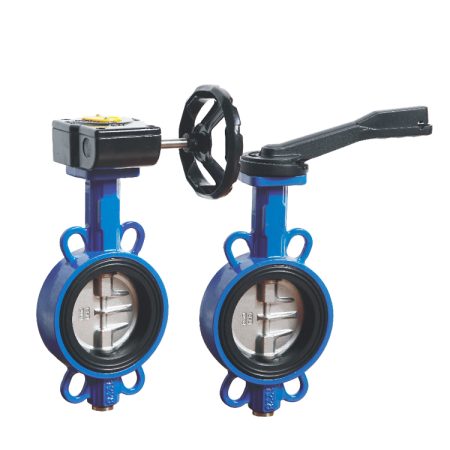
Proper alignment is also crucial for butterfly wafer type valve. The valve disc must be precisely aligned with the valve seat to ensure a tight seal and avoid fluid leakage. Misalignment can cause the valve to bind or fail to seal properly, leading to reduced performance and increased wear on valve components. Therefore, it is essential to ensure that the valve body and adjacent flanges are aligned correctly during installation, using appropriate tools such as alignment pins or jacks.
In summary, correct installation and alignment of butterfly wafer type valves are essential for achieving optimal performance and preventing premature wear and failure. Proper installation ensures that the valve operates efficiently, while correct alignment ensures reliable sealing performance and extends the valve’s service life. By following the manufacturer’s installation instructions and proper alignment procedures, users can achieve trouble-free operation and maximize their investment in these versatile flow control devices.
Proper orientation and positioning of the valve
Proper orientation and positioning of butterfly wafer type valves are critical for their reliable and efficient operation. The valve orientation determines the direction of flow and must be installed appropriately for the specific application. Incorrect orientation can cause the valve to experience excessive flow resistance, leading to reduced performance and increased wear on valve components. In addition, the valve’s positioning must be correct, as an incorrect position can cause the valve to bind or fail to seal properly, leading to fluid leakage. Therefore, it is essential to follow the manufacturer’s instructions regarding valve orientation and positioning during installation. Proper orientation and positioning ensure that the valve operates efficiently, maintains a reliable seal, and extends its service life, contributing to the safe, stable, and sustainable operation of the piping system.
Ensuring flange surfaces are clean and undamaged
Ensuring that flange surfaces are clean and undamaged is critical for achieving optimal sealing performance in butterfly wafer type valves. Flange surfaces must be free of debris, rust, or corrosion that can interfere with the valve’s ability to seal properly against the adjacent flange. Surface damage such as scratches, dings, or pitting can also compromise the valve’s sealing performance and lead to leaks or premature wear. Therefore, it is essential to carefully inspect the flange surfaces before installation, using appropriate tools such as wire brushes or sandpaper to remove any debris or corrosion. The flanges should also be checked for damage and repaired or replaced if necessary. Once the flange surfaces are clean and undamaged, the gasket material can be installed to ensure proper sealing between the valve and adjacent flange. By ensuring that flange surfaces are clean and undamaged, users can achieve reliable sealing performance and extend the valve’s service life, contributing to the overall efficiency and reliability of the piping system.
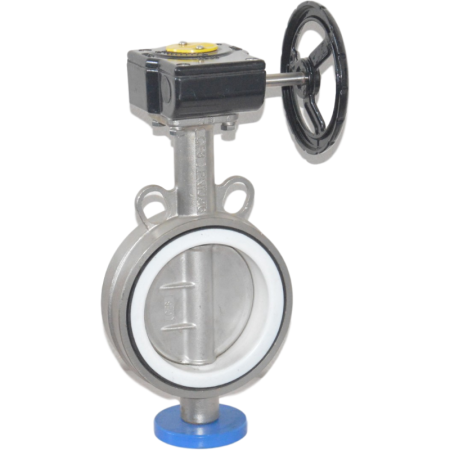
Gasket selection and placement
Gasket selection and placement are critical factors in ensuring optimal sealing performance in butterfly wafer type valve. Gaskets must be compatible with the fluid being transported through the piping system and must be installed correctly to prevent leaks. Common gasket materials for butterfly wafer type valves include elastomers such as EPDM, Buna-N, or Viton, which provide good sealing performance against a wide range of fluids and temperatures. Gaskets can be placed on either side of the valve disc, depending on the specific application requirements. Care must be taken to ensure that the gasket is centered properly and that there are no wrinkles or folds that can interfere with the valve’s sealing performance. Torque settings for the flange bolts must also be followed precisely to ensure that the gasket is compressed evenly and that there is no leakage. By selecting the appropriate gasket material and placing it correctly, users can achieve reliable sealing performance and extend the valve’s service life, contributing to the overall efficiency and reliability of the piping system.
Bolting patterns and torque specifications
Bolting patterns and torque specifications are critical factors in ensuring optimal sealing performance in butterfly wafer type valve. The valve’s flange bolting pattern must match the adjacent piping system’s flange pattern to ensure a secure and tight seal between the valve and the adjacent flange. Bolts must be tightened evenly and in a cross-pattern to distribute the load evenly and prevent binding or distortion of the valve components. Improper bolt tightening can cause leaks or damage to the valve components, so it is essential to use the recommended torque specifications indicated by the manufacturer. Bolts should be tightened gradually and in stages, alternating between bolts in a cross or star pattern until the specified torque is achieved. Additionally, bolts should be checked periodically for tightness and re-torqued if necessary to ensure continued optimal sealing performance. By following the proper bolting pattern and torque specifications, users can achieve reliable sealing performance and extend the valve’s service life, contributing to the overall efficiency and reliability of the piping system.
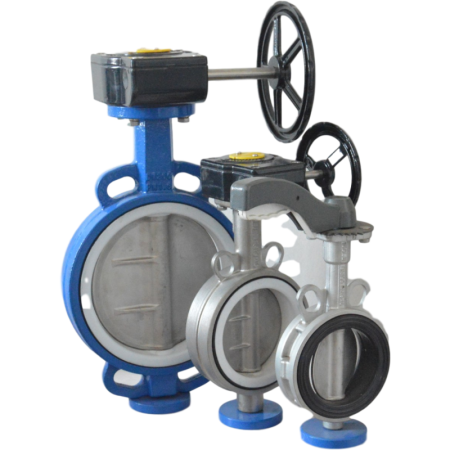
Regular inspection and maintenance
Regular inspection and maintenance are critical for ensuring the long-term reliability and optimal performance of butterfly wafer type valve. Over time, valve components can wear or become damaged, which can cause leaks or reduce valve efficiency. Regular inspection and maintenance can identify these issues early, preventing costly repairs or replacements down the line. During inspections, valve components such as the disc, stem, and seat should be checked for wear, corrosion, or damage. The gasket material should also be inspected for signs of deterioration or damage, and replaced as necessary. Additionally, the valve’s performance should be monitored, checking for any changes in flow rate, pressure, or temperature that could indicate a problem with the valve. Routine maintenance tasks such as lubrication, cleaning, and tightening of bolts should also be performed as recommended by the manufacturer. By following a regular inspection and maintenance schedule, users can ensure that the valves in their piping systems operate reliably and efficiently throughout their service life, contributing to the safe, stable, and sustainable operation of the entire system. Regular inspection and maintenance are essential for maximizing the investment in butterfly wafer type valves and ensuring the overall efficiency and reliability of the piping system.
Periodic visual inspections for signs of wear or damage
Periodic visual inspections for signs of wear or damage are essential for maintaining the reliable and efficient operation of butterfly wafer type valve. During these inspections, valve components such as the disc, stem, and seat should be checked for any signs of wear, corrosion, or damage that could lead to reduced performance or leaks. The gasket material should also be inspected for signs of deterioration or damage that could compromise the valve’s sealing performance. Additionally, the valve’s exterior should be checked for any signs of deformation or damage that could affect its ability to operate correctly. These inspections should be performed periodically, depending on the specific application requirements, and any issues identified should be addressed promptly to prevent further damage or failure. By performing periodic visual inspections, users can ensure that their butterfly wafer type valves continue to operate reliably and efficiently, contributing to the safe, stable, and sustainable operation of the entire piping system.
Functionality tests to confirm proper operation
Functionality tests are essential for confirming the proper operation of butterfly wafer type valve. These tests should be performed periodically to ensure that the valve is functioning correctly and remains in good condition. During these tests, the valve’s performance should be monitored, checking for any changes in flow rate, pressure, or temperature that could indicate a problem with the valve. The valve’s actuator should also be checked for proper response to control signals and correct motion. Additionally, the valve’s sealing performance should be confirmed by performing a leak test, checking for any signs of fluid leakage around the valve or adjacent flanges. These functionality tests should be performed in accordance with the manufacturer’s recommendations and any issues identified should be addressed promptly to prevent further damage or failure. By performing functionality tests, users can ensure that their butterfly wafer type valves continue to operate reliably and efficiently, contributing to the safe, stable, and sustainable operation of the entire piping system.
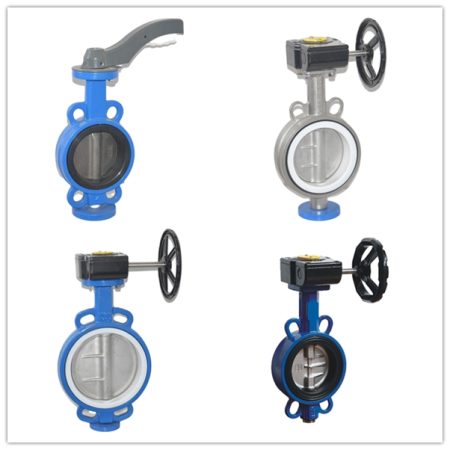
Scheduled maintenance tasks (lubrication, cleaning, and component replacements)
Scheduled maintenance tasks such as lubrication, cleaning, and component replacements are essential for maintaining the reliable and efficient operation of butterfly wafer type valves. Lubrication is essential to prevent wear and tear on valve components, ensuring that they operate smoothly and efficiently. Lubrication should be performed periodically using a manufacturer-recommended lubricant. Cleaning is also critical to prevent debris or corrosion from building up on valve components, which can affect their performance. Components such as the stem, seat, and disc should be cleaned periodically using an appropriate cleaning agent. Component replacements should also be included in scheduled maintenance tasks, especially for components prone to excessive wear or damage, such as gaskets. The manufacturer’s recommendations should be followed when replacing components to ensure compatibility with the valve and its specific application requirements. By performing scheduled maintenance tasks, users can ensure that their butterfly wafer type valves continue to operate reliably and efficiently throughout their service life, contributing to the safe, stable, and sustainable operation of the entire piping system.
Identifying and addressing common issues (seat wear, disc misalignment, and stem leaks)
Identifying and addressing common issues such as seat wear, disc misalignment, and stem leaks is essential for maintaining the reliable and efficient operation of butterfly wafer type valves. Seat wear is a common issue that can lead to leaking. During inspections, the valve’s seat should be checked for wear, and any signs of damage or wear should be addressed promptly to prevent further deterioration and potential leaks. Disc misalignment can also cause leaks, and the valve’s discs should be checked periodically to ensure they are properly aligned with the seat. Stem leaks can occur due to damaged or worn stem seals and packing. These components should be inspected regularly and replaced as necessary to prevent leaks. By identifying and addressing these common issues promptly, users can prevent more severe problems from developing and ensure that their butterfly wafer type valves continue to operate reliably and efficiently, contributing to the safe, stable, and sustainable operation of the entire piping system.
Consultation with professionals and adherence to best practices
Consultation with professionals and adherence to best practices is essential for ensuring the reliable and efficient operation of butterfly wafer type valve. Professionals such as engineers, technicians, and manufacturers can provide valuable insights into valve selection, installation, operation, and maintenance. Before selecting a valve, it is recommended to consult with a professional engineer to determine the most appropriate valve type and size for the specific application requirements. During installation, it is essential to follow the manufacturer’s recommendations and adhere to best practices to prevent damage or misalignment of valve components, which can affect its performance. Adherence to best practices also includes proper torquing of bolts, following the correct bolting pattern, and use of gaskets and fasteners that comply with industry standards. Professionals can also provide valuable guidance on routine maintenance tasks such as lubrication, cleaning, and component replacements, to ensure that the valve remains in good condition throughout its service life. By consulting with professionals and adhering to best practices, users can minimize the risk of valve failure or inefficient operation, contributing to the safe, stable, and sustainable operation of the entire piping system.
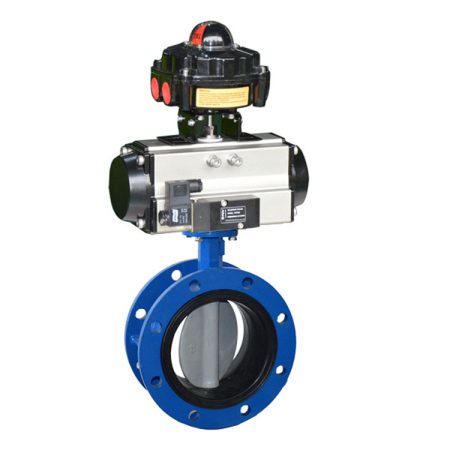
Benefits of engaging with experienced professionals
Engaging with experienced professionals can provide numerous benefits in maintaining the reliable and efficient operation of butterfly wafer type valves. Professionals such as engineers, technicians, and manufacturers possess a wealth of technical knowledge and expertise that can be invaluable in selecting, installing, operating, and maintaining valves. By engaging with professionals, users can benefit from their insights, recommendations, and guidance, which can help prevent problems, reduce downtime, and extend the service life of the valves. Professionals can also provide valuable support in troubleshooting problems, identifying root causes, and implementing effective solutions to address issues promptly and prevent recurrence. Additionally, professionals can keep users informed of new technologies, industry standards, and best practices, ensuring that they remain up-to-date and able to optimize the performance of their piping systems. Engaging with experienced professionals can ultimately lead to better cost-effectiveness, increased efficiency, and improved safety, contributing to the long-term success and sustainability of the entire piping system.
Importance of following industry standards and guidelines
Following industry standards and guidelines is essential for ensuring the reliable and safe operation of butterfly wafer type valve. Standards and guidelines are developed by industry professionals and organizations to provide common practices, minimum requirements, and best practices for valve selection, installation, operation, and maintenance. These standards and guidelines ensure that valves are installed and maintained properly, operate efficiently, and comply with safety and environmental regulations. Adhering to these standards and guidelines also helps prevent accidents, reduces downtime, and extends the service life of valves. Additionally, following industry standards and guidelines can provide legal protection and limit liability in case of accidents or failures. It is crucial to stay informed of industry standards and guidelines and ensure compliance throughout the valve’s service life. By following industry standards and guidelines, users can ensure the reliable, safe, and sustainable operation of their butterfly wafer type valves, contributing to the overall success and sustainability of the entire piping system.
Continuous learning and improvement for optimal valve performance
Continuous learning and improvement are critical for achieving optimal performance of butterfly wafer type valve. New technologies, industry standards, and best practices emerge over time, and it is essential to stay informed and adapt accordingly to optimize valve performance. By continuously learning and improving, users can identify opportunities to enhance valve performance and prevent problems before they occur. This may include investing in new technologies, developing new maintenance procedures, or adopting new safety measures. Continuous learning and improvement also involve seeking feedback from professionals, end-users, and other stakeholders to identify areas for improvement and implement effective solutions. Ultimately, continuous learning and improvement can help ensure that butterfly wafer type valves operate reliably, efficiently, and safely, contributing to the long-term success and sustainability of the entire piping system.
Conclusion
In conclusion, proper sealing is critical when using electric butterfly valve to prevent leakage and ensure efficient operation of the valve. There are several ways to ensure proper sealing, including selecting the appropriate valve size and type, following manufacturer recommendations for installation and maintenance, and adhering to industry standards and guidelines. It is also essential to identify and address common issues such as seat wear, disc misalignment, and stem leaks promptly to prevent more severe problems from developing.
Consultation with professionals can provide valuable insights into valve selection, installation, operation, and maintenance, and adherence to best practices can help prevent damage or misalignment of valve components. Continuous learning and improvement are also crucial for achieving optimal performance of butterfly wafer type valves, as new technologies, industry standards, and best practices emerge over time.
By ensuring proper sealing, users can avoid costly downtime, reduce the risk of accidents, and contribute to the safe, stable, and sustainable operation of the entire piping system. Proper sealing ultimately requires a comprehensive approach that takes into account all aspects of valve selection, installation, operation, and maintenance. By following these guidelines, users can achieve the highest level of performance and reliability from their butterfly wafer type valves.
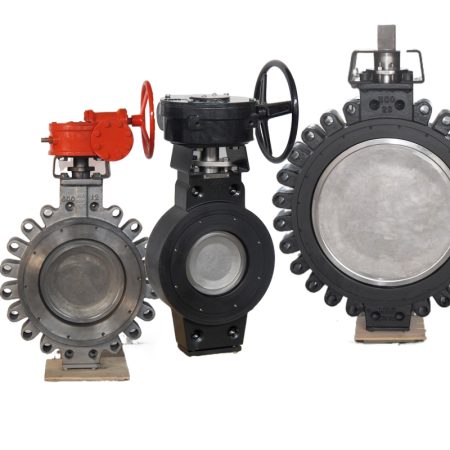
Recap of key factors for ensuring proper sealing in butterfly wafer type valves
To recap, ensuring proper sealing in butterfly wafer type valve requires attention to several key factors. First, selecting the appropriate valve size and type for the specific application requirements is essential. Second, following manufacturer recommendations for installation, operation, and maintenance can help prevent damage or misalignment of valve components. Third, adhering to industry standards and guidelines can ensure compliance with safety and environmental regulations. Fourth, identifying and addressing common issues such as seat wear, disc misalignment, and stem leaks promptly can prevent more severe problems from developing. Fifth, consultation with professionals can provide valuable insights and guidance throughout the valve’s service life. Finally, continuous learning and improvement are critical for achieving optimal valve performance and sustainability. By taking a comprehensive approach that addresses all these factors, users can ensure that their butterfly wafer type valves operate reliably, efficiently, and safely, contributing to the long-term success and sustainability of the entire piping system.
Emphasis on material selection, installation, maintenance, and professional consultation
Emphasis on material selection, installation, maintenance, and professional consultation is crucial for ensuring the reliable and efficient operation of butterfly wafer type valves. Material selection plays a critical role in determining the valve’s durability, corrosion resistance, and ability to withstand high pressure and temperature. Installation that adheres to best practices, including proper bolting patterns, torqueing of bolts, and use of gaskets, can ensure proper alignment, preventing damage or misalignment of valve components. Maintenance tasks such as regular lubrication, cleaning, and component replacements are essential to keep the valve in good condition throughout its service life. Finally, consultation with professionals, including engineers, technicians, and manufacturers, can provide valuable insights and guidance throughout the valve’s service life, ensuring that it remains up-to-date and optimized for optimal performance. By prioritizing these factors, users can improve the longevity, efficiency, and safety of their butterfly wafer type valves, contributing to the overall success and sustainability of the entire piping system.
Encouragement to follow best practices for reliable and efficient valve operation
Encouragement to follow best practices for reliable and efficient valve operation is essential for ensuring the long-term success and sustainability of the entire piping system. Best practices, including material selection, installation, maintenance, and professional consultation, can help prevent accidents, reduce downtime, and extend the valve’s service life. Adherence to industry standards and guidelines can ensure compliance with safety and environmental regulations, providing legal protection and limiting liability in case of failures or accidents. Continuous learning and improvement are also critical for achieving optimal valve performance, as new technologies, industry standards, and best practices emerge over time. By following best practices for butterfly wafer type valves, users can achieve the highest level of reliability, efficiency, and safety, contributing to the overall success and sustainability of the entire piping system.


